Genus Tetramorium species-groups -
Part 1
| The
Ants of Africa Genus Tetramorium species-groups - Part 1 |
|
| Tetramorium Introduction |
DIV1
Species groups
Part 1
- former Triglyphothrix
| Some
or all erect hairs of dorsum of
head or body branched (bifid, trifid or quadrifid) Triglyphothrix Otherwise |
|||
| grebennikovi-group | Small
species, TL ca 2.0, without
elongate simple hairs in a row on the anterior edges of the scapes or
along the upper borders of the scrobes Otherwise |
||
| -- | Head
rectangular with
width much less than length, CI 84; very strongly reticulo-rugose;
mandibles smooth; clypeus without a raised tranverse carina; gaster
with distinctive minute hair pits; TL ca 2.0 mm; dark brown, appendages
golden-brown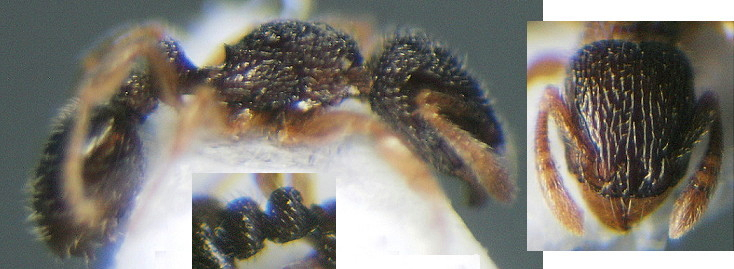 |
Tetramorium grebennikovi | Tanzania
- new species |
| ericae-group | Very
small to minute species (TL
< 2.4 mm), all with elongate simple hairs in a row on the
anterior edges of the scapes and along the upper borders of the scrobes Otherwise |
||
| 11-segmented antennae, palp formula 3,3 | |||
| 02* | Much
reduced sculpture; TL 1.8 mm; black, tibiae yellowish-white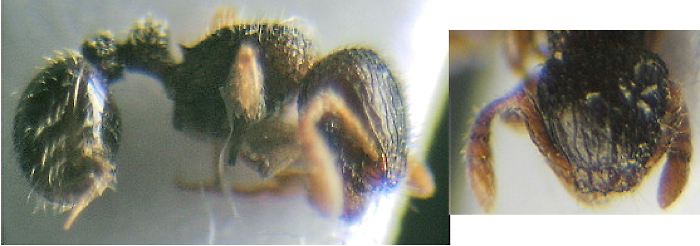 |
Tetramorium antrema | Cameroun & Congo |
| 03* | Distinctly
reticulo-rugose; clypeus with a raised tranverse carina; eyes
with a distinctive anterior point; TL 1.6-1.9 mm; yellow-brown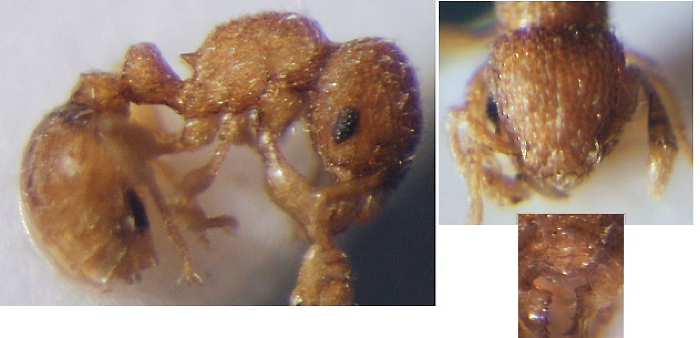 |
Tetramorium muscorum | Pan-African forests |
| 03* | Distinctly
reticulo-rugose; clypeus without a raised transverse carina;
TL 1.9-2.1 mm; head with long simple hairs; gaster and postpetiole
smooth & shining; black, appendages yellow-brown (Cameroun specimen
shown is somewhat lighter)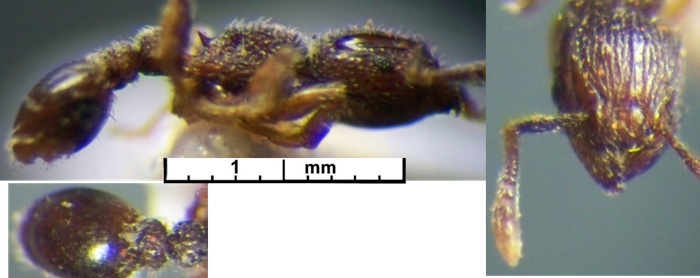 |
Tetramorium crypticum | Ghana & Cameroun |
| 12-segmented antennae, palp formula normal 4,3 | |||
| 12* | Strongly
bicoloured, head and gaster black, rest clear yellow; TL 1.7-1.9 mm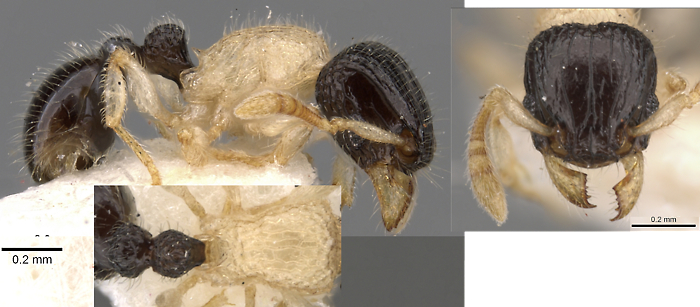 |
Tetramorium distinctum | Ghana |
| - | Unicolourous or at most with darker gaster | ||
| 10* | Dorsal
surfaces of
head and alitrunk unsculptured other than median carina on head; TL
2.3-2.4 mm; dark blackish-brown |
. | . |
| . | .
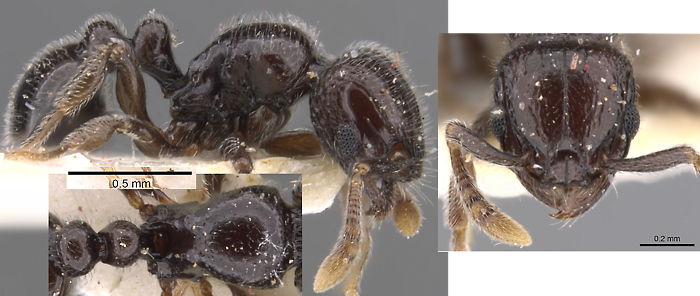 |
Tetramorium menkaura | Ghana |
| 13* | Clypeus with a
raised tranverse carina; TL 1.7-2.0 mm; dark brown, appendages lighter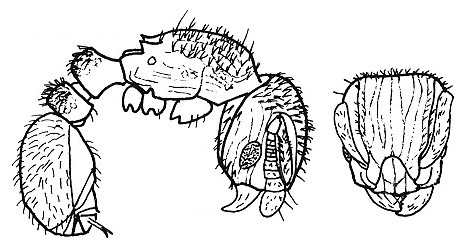 |
. | . |
| . |  |
Tetramorium minimum | West African & Congo Basin forests |
| 15* (as paupera) | Clypeus
without a raised tranverse carina; TL
1.8-2.0 mm; yellow to mid-brown, gaster may be darker |
Tetramorium ericae | Zimbabwe |
| osiris-group | Larger
and gaster with dense mat of
quadrifid hairs; both upper scrobe margins and leading edges of scapes
with a row of elongate simple hairs Otherwise |
||
| 23* | With
very strong
antennal scrobes and few erect long hairs; propodeum with short stout
spines; petiole profile high (apex 0.65 x height); TL 3.4 mm; light
yellowish-brown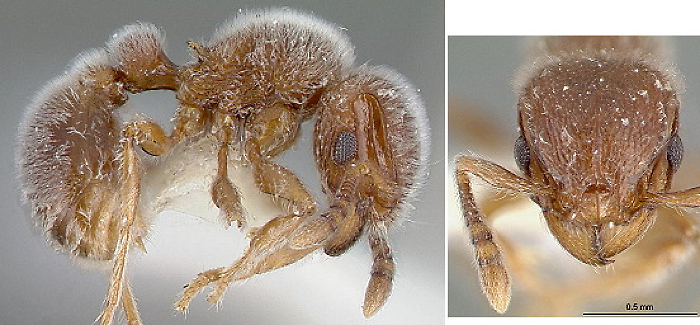 |
Tetramorium reptana | Uganda |
| NA |
Upper scrobe margins with obvious
sngle hairs; first gastral
tergite smooth but with small hair pits; petiole profile relatively low
(apex 0.88 x height); TL
3.8 mm, head rectangular, CI 84; yellow-brown with slightly darker
gaster 3.8 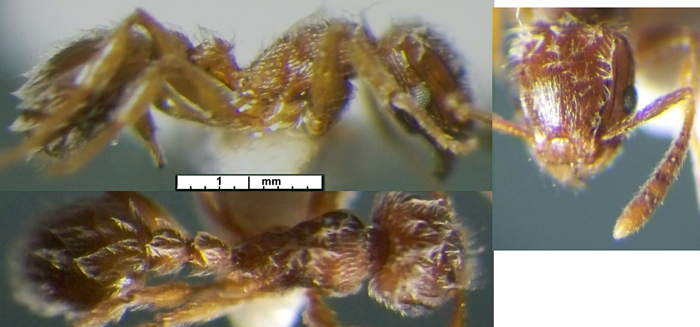 |
Tetramorium nsp Cameroun fk 20 | Cameroun |
| 14* | Anterior
of first gastral tergite with coarse
punctate sculpture; TL 3.4 mm; uniform dark brown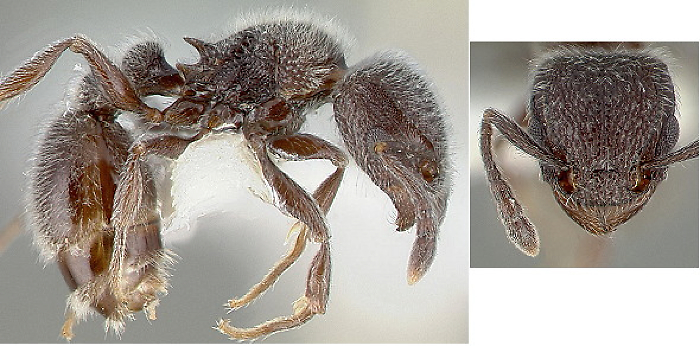 |
Tetramorium yarthiellum | Zambia |
| 16* | First gastral
tergite smooth; distinctive narrow down-curved propodeal spines; TL
2.8-2.9 mm; brown with much darker gaster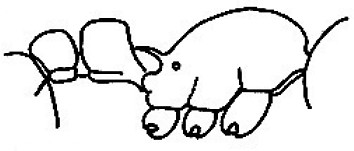 |
. | . |
| . | 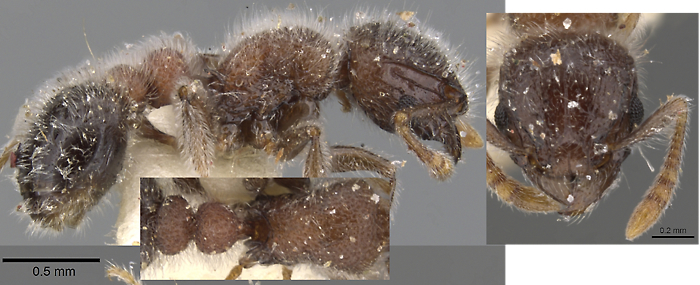 |
Tetramorium osiris | Ghana |
| NA | Basal
segment of gaster smooth and shining; propodeal spines quite long and
distinctly upturned; TL 2.2-3.0 mm; petiole node evenly but shallowly
domed; variable
yellowish-brown to dark brown, gaster often darker (Egypt specimen)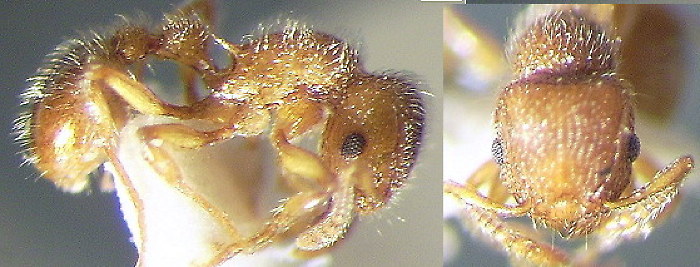 |
Tetramorium lanuginosum | for comparison - sub-tropical tramp
species (includes Egypt) |
| rothschildi-group | Large
species, lacking antennal
scrobes; anterior clypeal margin with deep median impression Otherwise |
||
| 06* | TL 3.8-4.7 mm;
red-brown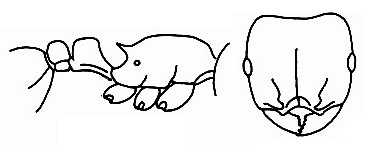 |
. | ./td> |
| . | 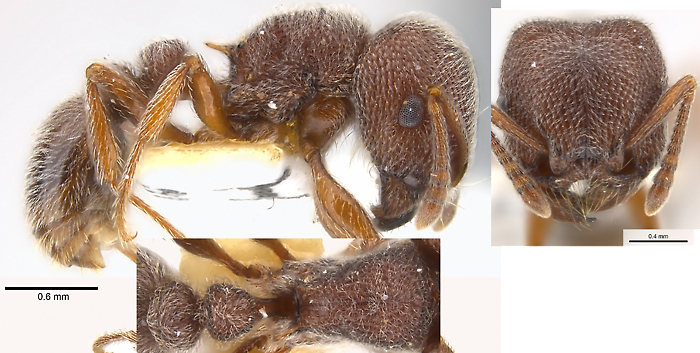 |
Tetramorium rothschildi | Dry southern Sahel Ethiopia, Kenya & Ghana |
| inezulae-group | Without
long simple hairs on scapes
but with a row on the upper scrobe margin; most with compressed petiole
node Otherwise |
||
| 07* | Uniquely,
without
branched hairs; alitrunk dorsum densely reticulo-punctate; TL
2.4-2.9 mm; yellow-brown |
Tetramorium arnoldi | Zimbabwe |
| 10* | Without
propodeal spines; TL 2.4 mm; dorsum of head and alitrunk
rugulose; clear ferruginous brown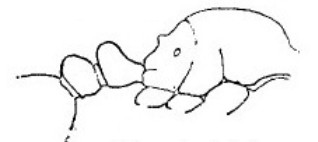 |
. | . |
| . | 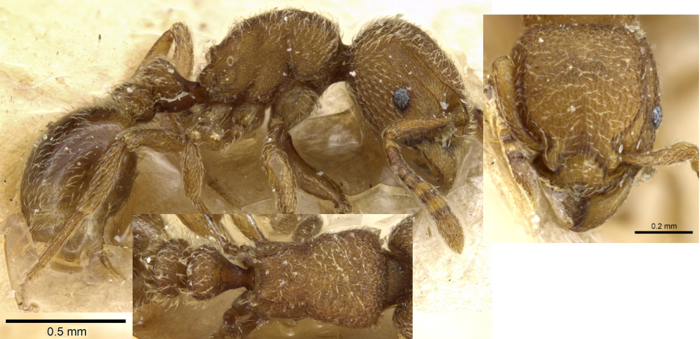 |
Tetramorium imbelle | Ethiopia |
| TL max 3.3 mm | . | . | . |
| 22* | Yellow
or
light yellow-brown; TL 1.8-2.1 mm; CI 89-95; dorsal alitrunk
finely rugo-reticulate; 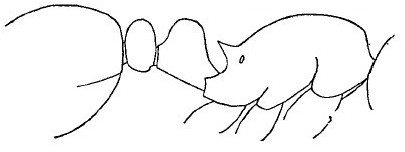 |
. | . |
| . |
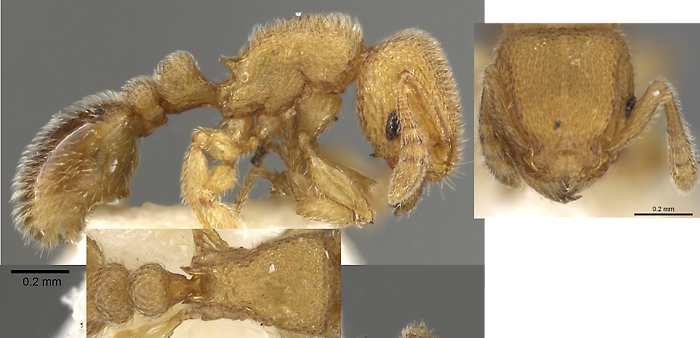 |
Tetramorium gestroi | Southern
area of wet forests Angola, Gabon and Uganda |
| Dark brown to black | . | . | . |
| 22* | TL
2.2-2.5 mm; CI
90-96; base of gaster smooth; eyes small; antennal
scrobe with strong longitudinal median carina; dorsal alitrunk
longitudinally rugose; black to blackish-brown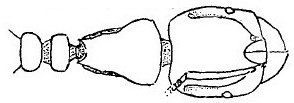 |
. | . |
| . |
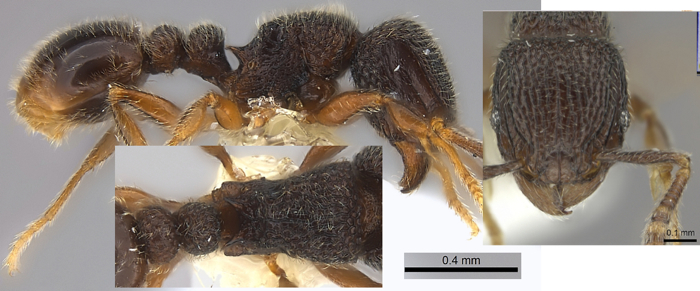 |
Tetramorium furtivum | Wet
western forests Angola to Ghana |
| 20* | Base of gaster densely
punctate;
antennal scrobe with weak median longitudinal carina, lower
portion of scrobe sculptured above the eye; mandibles striate; TL
2.2-2.3 mm, CI 86-92; dark brown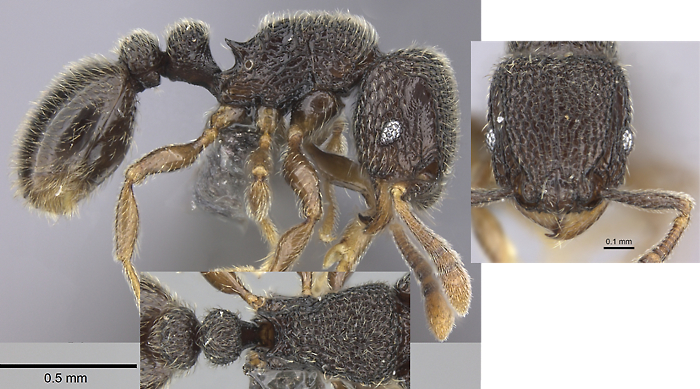 |
Tetramorium trimeni | South Africa |
| 20* | Base
of
gaster densely punctate; antennal scrobe with strong longitudinal
median carina; TL 2.5-3.3 mm, CI 90-97; medium to dark brown |
. | . |
| . |
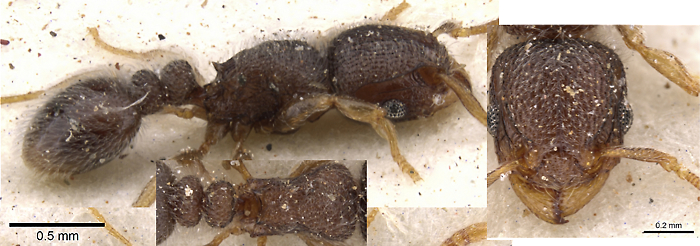 |
Tetramorium inezulae | East
Africa includes eastern Zaïre |
| (17*) | Worker not known - may be sexuals of inezulae | Tetramorium desertorum | Botswana |
| TL at least 3.4 mm | . | . | . |
| 17* | Eyes
minute,
diameter less than width of scape; TL 3.4-3.7 mm; mandibles striate;
sculpturation rugulose and weakly longitudinal; yellow to yellow-brown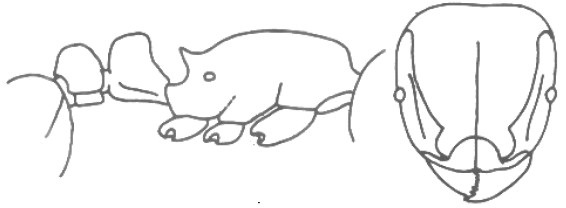 |
. | . |
| . |
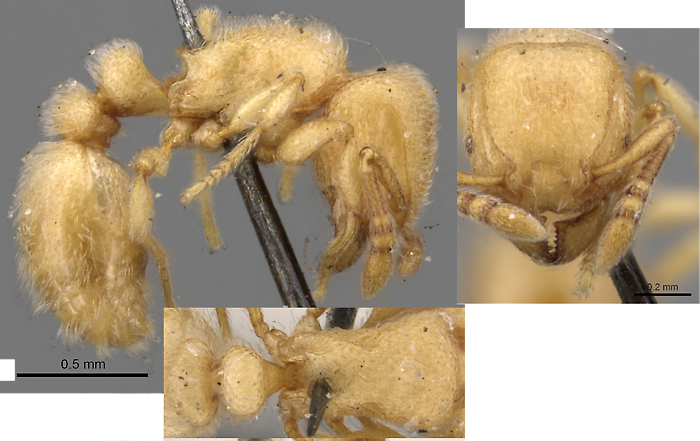 |
Tetramorium microps | Southern Africa |
| 19* | First
gastral tergite with only simple hairs; TL 3.6-3.8 mm; pale
yellow-brown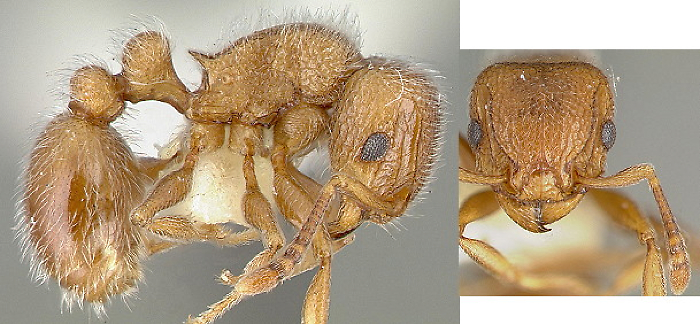 |
Tetramorium talpa | Eastern Zaïre |
| 21* | Large
species TL
3.6-3.8 mm; brown, gaster usually darker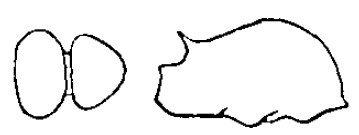 |
. | . |
| . |
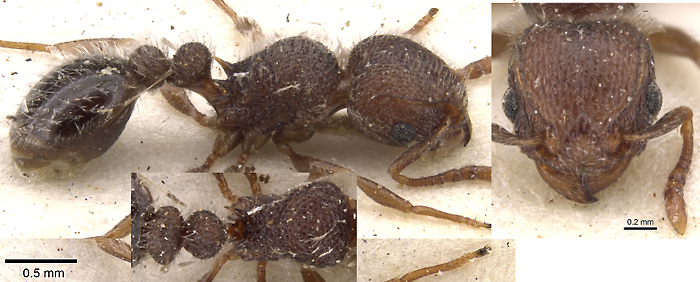 |
Tetramorium tenebrosum | Mozambique & Kenya |
| gabonense-group | Stocky with overall covering of branched trifid or quadrifid hairs | ||
| - | Without antennal scrobes | ||
| 05* | Propodeum
unarmed; TL 3.5 mm; brown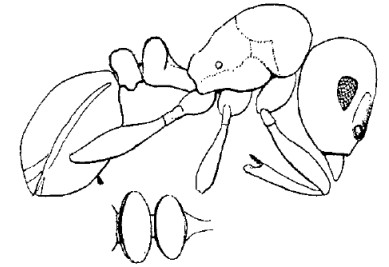 |
. | . |
| . | 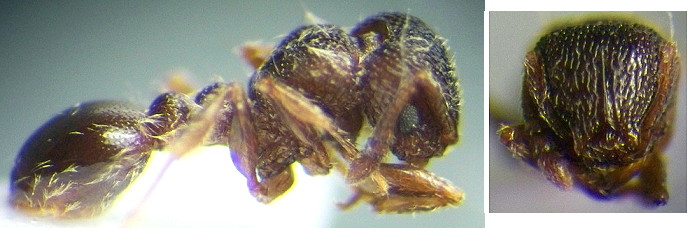 |
Tetramorium agnum | Zaïre & Congo |
| 06* | Propodeum
with short teeth; TL 2.7-3.6 mm; dark brown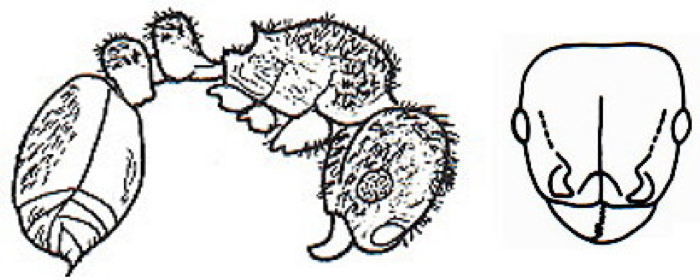 |
. | . |
| . | 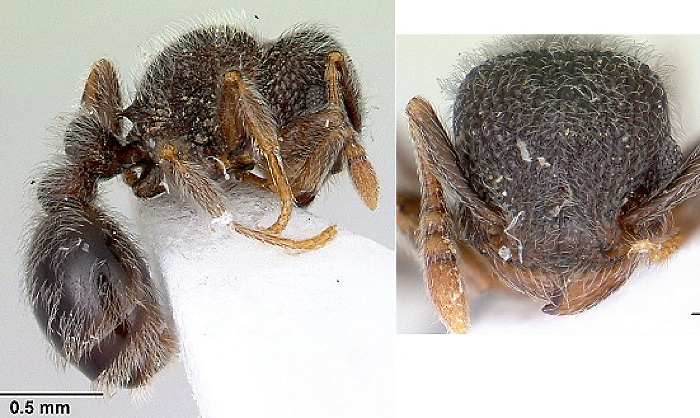 |
Tetramorium eminii | Pan-African |
| - | With well developed antennal scrobes | ||
| 23* | Propodeum
unarmed; minute TL 2.3 mm; uniform light brown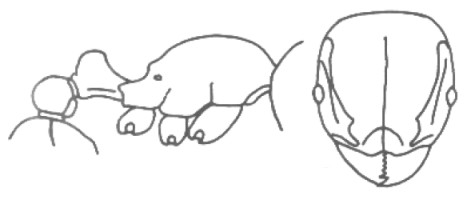 |
. | . |
| . | 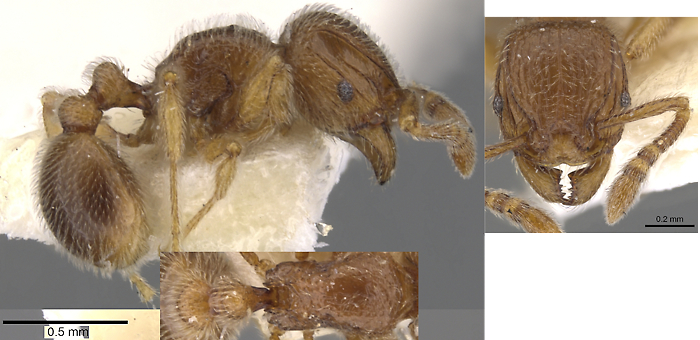 |
Tetramorium dedefra | Angola & Uganda |
| - | Propodeum with spines or acute teeth | ||
| 24* |
Bicoloured, head bright
golden-yellow, rest blackish-brown; TL 2.7 mm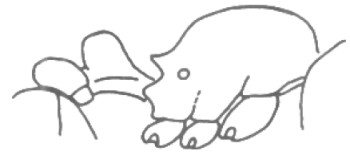 |
. | . |
| , |
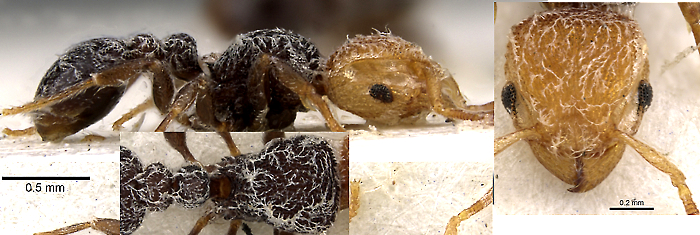 |
Tetramorium pulcherrimum | Forests of western Uganda & eastern Zaïre |
| - | Unicolourous; head and/or gaster may be darker than alitrunk | ||
| - | Branched hairs on dorsal surfaces all appressed, lying flat | . | . |
| 26* | 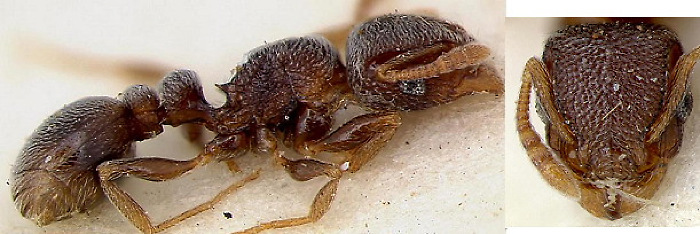 TL
2.3-2.8 mm, CI 93-97; gaster with basal band of punctate sculpture;
originally described as piceous, almost black, legs, antennae and
mandibles dark ochreous TL
2.3-2.8 mm, CI 93-97; gaster with basal band of punctate sculpture;
originally described as piceous, almost black, legs, antennae and
mandibles dark ochreous |
Tetramorium sericeum | Zimbabwe |
| new | 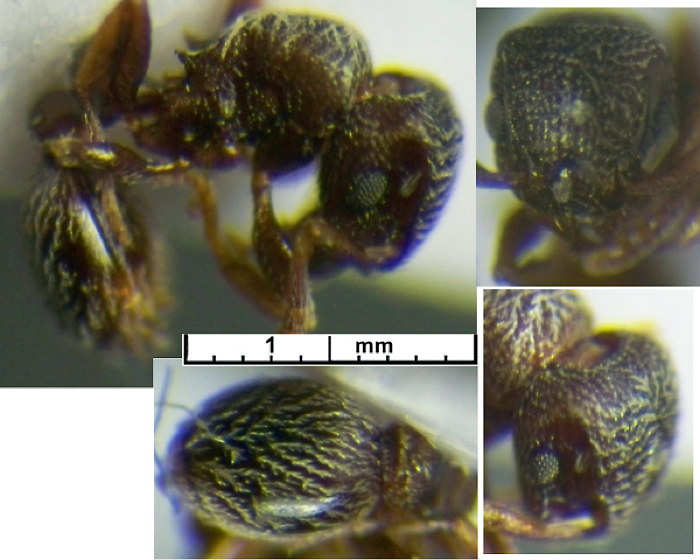 TL
2.4 mm, CI 91; head slightly squarer; branched hairs coarser and,
particularly on the gaster, distinctly bifid, arranged in distinctive
angled lines; gaster without obvious sculpturation; uniform dark
brown; TL
2.4 mm, CI 91; head slightly squarer; branched hairs coarser and,
particularly on the gaster, distinctly bifid, arranged in distinctive
angled lines; gaster without obvious sculpturation; uniform dark
brown; |
Tetramorium (Trig.) n. sp. Congo 2008 | Congo |
| - | Branched hairs on dorsal surfaces at least sub-erect | . | . |
| 30* | TL
2.4 mm;
mandibles smooth
& shining; mid-brown, legs lighter, yellow brown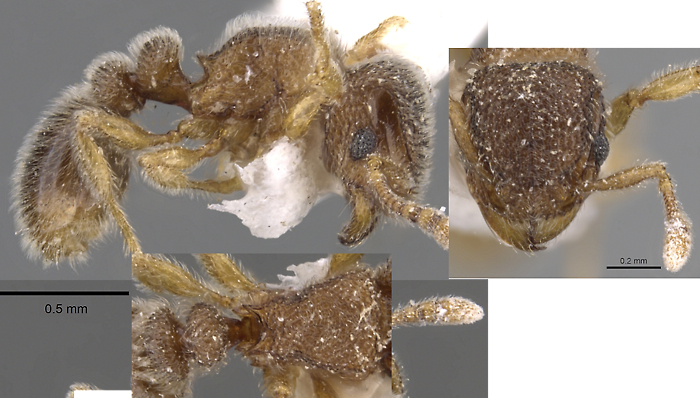 |
Tetramorium thoth | South Africa |
| TL > 3.0 mm | . | . | . |
| With long propodeal spines | . | . | . |
| 27* | Petiole
from above
strongly crescent shaped; TL 4.0 mm; dark brown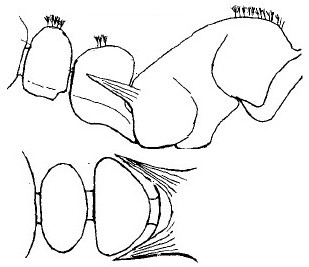 |
. |
. |
| . |
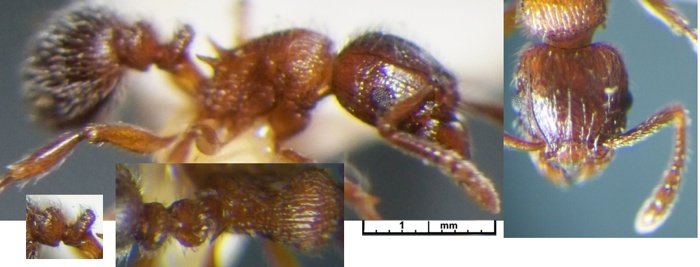 |
Tetramorium monardi | Cameroun & Angola |
| 32* | Clypeus with weak
or incomplete median carina; postpetiole with little or no
sculpturation; TL 3.8-4.6 mm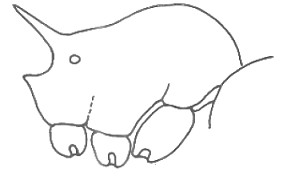 |
. | . |
| . | 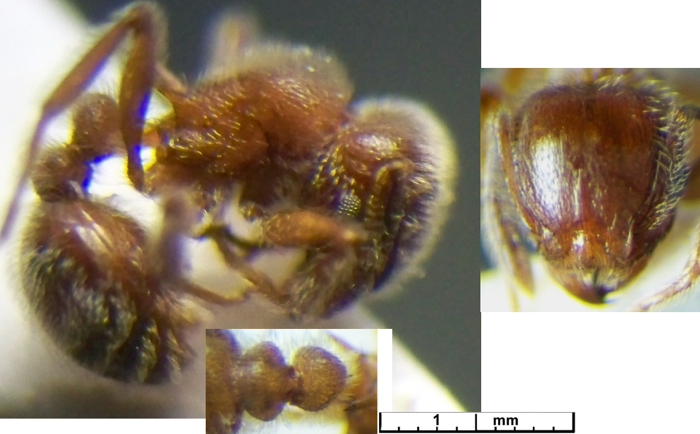 |
Tetramorium gabonense | Wet forests of Cameroun east to Central Africa |
| 32* | Clypeus
with strong median carina; postpetiole
strongly sculptured; TL 3.0-3.6 mm; uniform mid-brown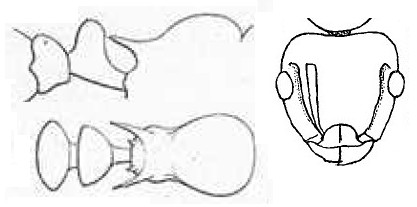 |
. | . |
| . |
 |
Tetramorium constanciae | East Africa |
| With reduced propodeal spines | . | . | . |
| 29* | Head
convex in
front view; lower portion of antennal scrobe densely reticulo-rugose;
TL 3.4 mm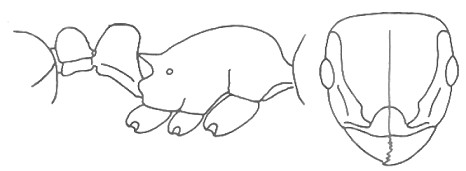 |
. | . |
| . |
 |
Tetramorium baufra | Zimbabwe |
| 31* | Petiole node from
above with convex anterior face; TL 3.2-3.9 mm; variable brown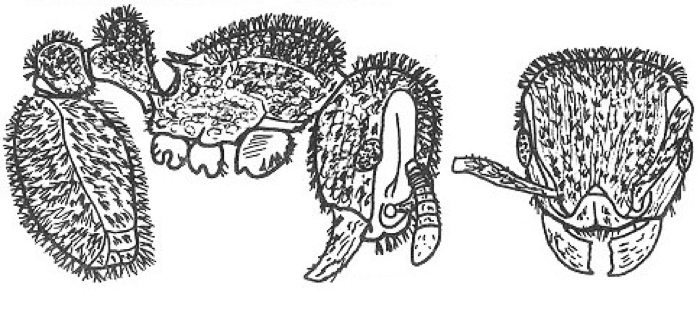 |
. | . |
| . | 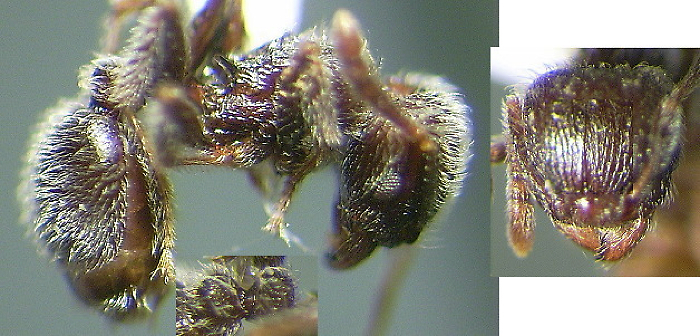 |
Tetramorium brevispinosum | Wet forests of West & Central Africa |
| 31* (as silvestrii) |
Petiole
node from above with flat anterior
face; smaller TL 3.1 mm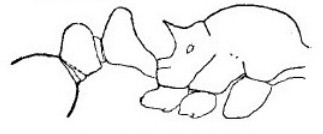 |
. | . |
| . |
 |
Tetramorium surrogatum | Ethiopia |
|
©
2007, 2008, 2009, 2010, 2011, 2013 - Brian Taylor CBiol FSB FRES 11, Grazingfield, Wilford, Nottingham, NG11 7FN, U.K. |
href="tetramorium_groups_1.htm"